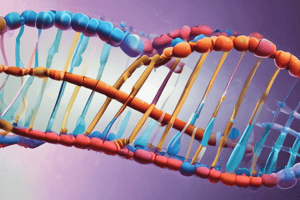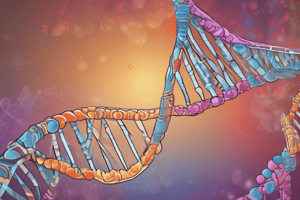Podcast
Questions and Answers
During DNA replication, which enzyme is responsible for relieving the tension in the DNA molecule as it is unwound?
During DNA replication, which enzyme is responsible for relieving the tension in the DNA molecule as it is unwound?
- RNA polymerase
- Topoisomerase (correct)
- DNA polymerase
- Helicase
What is the term for the process by which a cell makes an exact copy of its DNA before cell division?
What is the term for the process by which a cell makes an exact copy of its DNA before cell division?
- DNA Replication (correct)
- Molecular Evolution
- Protein Synthesis
- Gene Expression
In protein synthesis, what is the role of aminoacyl-tRNA synthetases?
In protein synthesis, what is the role of aminoacyl-tRNA synthetases?
- To assemble amino acids
- To link amino acids to tRNA (correct)
- To read mRNA
- To terminate protein synthesis
What is the central dogma of molecular biology?
What is the central dogma of molecular biology?
During DNA replication, what is the function of the RNA primers?
During DNA replication, what is the function of the RNA primers?
What is the primary function of post-translational modifications in protein synthesis?
What is the primary function of post-translational modifications in protein synthesis?
Which of the following types of molecular evolution involves genes introduced from another species?
Which of the following types of molecular evolution involves genes introduced from another species?
What is the primary advantage of next-generation sequencing (NGS) over Sanger sequencing?
What is the primary advantage of next-generation sequencing (NGS) over Sanger sequencing?
Which of the following is a key concept in molecular evolution?
Which of the following is a key concept in molecular evolution?
What is the primary goal of systems biology in the context of genomics?
What is the primary goal of systems biology in the context of genomics?
Flashcards are hidden until you start studying
Study Notes
DNA Replication
- Process by which a cell makes an exact copy of its DNA before cell division
- Semi-conservative: each new DNA molecule contains one old strand (template) and one new strand
- Steps:
- Initiation: unwinding of DNA, binding of replication fork
- Unwinding: helicase unwinds DNA, topoisomerase relieves tension
- Binding: primase adds RNA primers to template strands
- Elongation: DNA polymerase adds nucleotides to primers
- Proofreading: DNA polymerase checks for errors
- Ligation: DNA ligase seals gaps between nucleotides
Gene Expression
- Process by which information in DNA is used to synthesize a functional product
- Central Dogma: DNA → RNA → Protein
- Transcription:
- Initiation: RNA polymerase binds to promoter region
- Elongation: RNA polymerase adds nucleotides to mRNA
- Termination: transcription stops, mRNA is released
- Translation:
- Initiation: ribosome binds to mRNA
- Elongation: amino acids are added to polypeptide chain
- Termination: protein synthesis stops, polypeptide is released
Protein Synthesis
- Process by which a polypeptide chain is synthesized from a mRNA template
- Translation machinery:
- Ribosomes: read mRNA, assemble amino acids
- tRNA (transfer RNA): brings amino acids to ribosomes
- Aminoacyl-tRNA synthetases: link amino acids to tRNA
- Steps:
- Initiation: ribosome binds to mRNA, initiator tRNA
- Elongation: amino acids are added to polypeptide chain
- Termination: protein synthesis stops, polypeptide is released
- Post-translational modifications: proteins may undergo folding, modification, targeting
Molecular Evolution
- Study of evolutionary processes at the molecular level
- Key concepts:
- Neutral theory: most mutations are neutral, not affecting fitness
- Molecular clock: rate of molecular change is constant over time
- Phylogenetic analysis: reconstructing evolutionary relationships
- Types of molecular evolution:
- Orthologs: genes with same function, different species
- Paralogs: genes with same origin, different function
- Xenologs: genes introduced from another species
Genomics
- Study of structure, function, and evolution of genomes
- Key concepts:
- Genome: complete set of genetic information
- Proteome: complete set of proteins encoded by a genome
- Systems biology: study of biological systems as a whole
- High-throughput sequencing technologies:
- Sanger sequencing: dideoxy chain termination method
- Next-generation sequencing (NGS): parallel sequencing of millions of fragments
- Applications:
- Personalized medicine: tailoring treatment to individual genomes
- Synthetic biology: designing new biological systems
DNA Replication
- DNA replication occurs before cell division to create an exact copy of the cell's DNA
- The process is semi-conservative, resulting in two new DNA molecules, each containing one old strand (template) and one new strand
- Initiation involves unwinding of DNA and binding of replication fork
- Helicase unwinds DNA, and topoisomerase relieves tension during unwinding
- Primase adds RNA primers to template strands during binding
- DNA polymerase adds nucleotides to primers during elongation
- DNA polymerase checks for errors during proofreading
- DNA ligase seals gaps between nucleotides during ligation
Gene Expression
- Gene expression is the process of synthesizing a functional product from DNA information
- The Central Dogma outlines the flow of information: DNA → RNA → Protein
- Transcription is initiated when RNA polymerase binds to the promoter region
- RNA polymerase adds nucleotides to mRNA during elongation
- Transcription stops, and mRNA is released during termination
- Translation is initiated when a ribosome binds to mRNA
- Amino acids are added to the polypeptide chain during elongation
- Protein synthesis stops, and the polypeptide is released during termination
Protein Synthesis
- Protein synthesis is the process of synthesizing a polypeptide chain from a mRNA template
- Ribosomes read mRNA and assemble amino acids during translation
- tRNA brings amino acids to ribosomes during translation
- Aminoacyl-tRNA synthetases link amino acids to tRNA
- Initiation involves the binding of ribosome to mRNA and initiator tRNA
- Amino acids are added to the polypeptide chain during elongation
- Protein synthesis stops, and the polypeptide is released during termination
- Post-translational modifications include folding, modification, and targeting
Molecular Evolution
- Molecular evolution is the study of evolutionary processes at the molecular level
- The neutral theory states that most mutations are neutral and do not affect fitness
- The molecular clock concept suggests that the rate of molecular change is constant over time
- Phylogenetic analysis involves reconstructing evolutionary relationships
- Orthologs are genes with the same function in different species
- Paralogs are genes with the same origin but different functions
- Xenologs are genes introduced from another species
Genomics
- Genomics is the study of the structure, function, and evolution of genomes
- A genome is the complete set of genetic information in an organism
- A proteome is the complete set of proteins encoded by a genome
- Systems biology involves the study of biological systems as a whole
- Sanger sequencing uses the dideoxy chain termination method
- Next-generation sequencing (NGS) involves parallel sequencing of millions of fragments
- Personalized medicine involves tailoring treatment to individual genomes
- Synthetic biology involves designing new biological systems
Studying That Suits You
Use AI to generate personalized quizzes and flashcards to suit your learning preferences.




